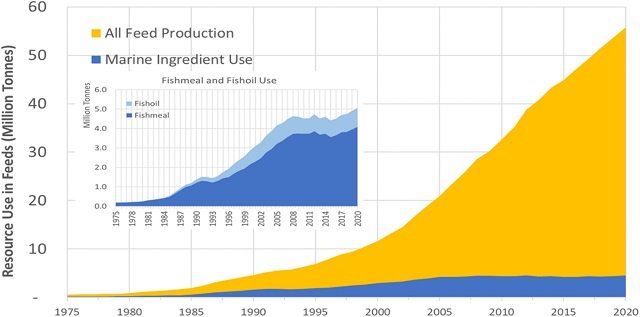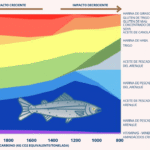
Researchers from the Institute of Aquaculture of the University of Stirling, the Federal University of Santa Catarina, James Cook University, the University of Las Palmas de Gran Canaria, the Ocean University of China, the Norwegian University of Life Sciences, among other international academic organizations published a scientific review examining three key issues underpinning feed formulation and the feeding process (requirements/ingredients/management) and framing the paper in past-present-future terms.
Nutritional requirements
Past (prior to 2010)
“The actual nutrient requirement of an animal is based more on the actual need for a particular nutrient required at a given metabolic body weight and for a defined duration (for example, mg protein/kg0.7/day), and for physiological functions defined as maintenance, maximum growth or optimal health”, they report.
Likewise, the researchers describe that the process to establish the nutritional requirements (optimal dietary levels) for aquaculture species has been a great challenge.
“Requirements can further depend on the farming system used and the region. In many cases, the production of key aquaculture species (carp, tilapia, catfish, salmon, trout and shrimp) was and still is in extensive, semi-intensive and integrated polyculture systems, which means that an integrated approach had to be used. holistic systems for nutrition rather than a monoculture approach,” they report.
According to the study, the definition of nutrient requirements for many species led to large gains in feed efficiency, with improvements in feed conversion factor values for many aquaculture species.
Current status (2010 – 2020)
Since 2010, small improvements in feed efficiency have been made, with typical changes in feed conversion for some species. These gains were a consequence of the increase in knowledge about nutritional requirements, but also due to better management practices as a consequence of the intensification of farming systems.
An increase in the level of fishmeal replacement with plant-based proteins in commercial aquaculture diets called for a better understanding of amino acid requirements.
This was especially important for carnivorous species, which have a higher demand for amino acids, but is also important for omnivores such as tilapia and shrimp, where the high cost of fishmeal limited its use in commercial feed.
Stay Always Informed
Join our communities to instantly receive the most important news, reports, and analysis from the aquaculture industry.
An interest emerged in knowing the role of the microbiome in the supply/utilization of nutrients.
Likewise, the growing need for immune-enhancing diets can be traced to problems of ill-defined micronutrient supply in the prevailing conditions associated with large-scale marine ingredient replacement without addressing all necessary issues comprehensively.
Consequently, functional feeds are being developed to improve animal health.
Future (2020 and beyond)
Analysis of changes in feed conversion factor values for most major species shows that improvements have leveled off for some time and only minor gains are now being achieved, leading to a point of diminishing returns for many species. species.
Any future work on the definition of requirements should focus more precisely on refining the estimates with greater consideration of nutrient interactions and the use of new, more stable forms of delivery, which help to reduce nutrient waste and increase the availability of nutrients. efficiency.
In the coming decades, the sustainability of aquaculture will continue to be a major concern.
There is an increasing need to prescribe the required levels of essential nutrients in the diet more accurately based on age, genotype, nutritional history, environment, culture system and immune status, and quality of the fish for provide a “precision nutrition” approach.
This will require the use of various modeling approaches (using big data), internet of things (IoT), and artificial intelligence (AI) to support aquaculture production and feed specification management.
Ingredients for aquafeeds
There have been marked changes in the use of aquafeed ingredients in recent decades. In this section, researchers review past and present practices to predict future trends and needs.
While not all aquaculture uses industrially produced compound feeds, this is the fastest growing feed sector in the world and indicators suggest that aquaculture production is increasingly intensifying and dependent on the supply of external feed inputs.
Food management and manufacturing
Past (before 2020)
Food rationing systems and managing how much and when food was delivered to the animal were largely based on previous experience or demand, and relied on the animal providing feedback to the person feeding it. fed.
Most feeding was manual, using hand, blower, or other simple delivery systems; therefore it was a labor demander.
Traditional feeding regimens were based on the experience of operators, considering factors such as weather, water color, season, and animal behavior, among others. The diet was selected according to the price and/or the recommendations of the food manufacturer.
Present (2010 – 2020)
Today, feed management systems in technologically advanced sectors are becoming increasingly computerized in modern aquaculture in the developed world.
Automated centralized air feeding systems using cage cameras, acoustics, and computer-based decision-making tools are widespread, resulting in a reduced level of labor.
However, in the developing world, where most aquaculture still takes place, feeding remains largely a manually controlled and managed process with significant labor demands and remains a major rural employer.
While feed manufacturing in the developed world relies primarily on modern extrusion technologies; In the developing world, there is still widespread use of pelleted, ground, and waste fish feed.
Future (after 2020)
By reducing the feed conversion rate, farmers will have less waste and loss of nutrients in the water they farm in, and will tend to reduce their overall carbon footprint.
To achieve this we need a better understanding of feed intake and its physiological set points and how this is affected by the production system (eg RAS, pond or cage) and a variety of other abiotic factors.
In the future, the study authors predict, we will see increasing use of mechanized and automated feeding in the developing world, matching that already taking place in much of the developed world.
The use of mechanized and automated feeding will help improve production efficiency (through less waste) and animal growth rates (through higher consumption) and commercial quality (by meeting market requirements) by allowing a better alignment of feed with the demand and needs of the animals that are raised, but this will consequently reduce the demand for labor and employment in the sector.
The use of Artificial Intelligence in food systems is emerging. The increasing use of centralized computer controlled feeding systems and cage/pond sensors and cameras will make an Internet of Things control system increasingly feasible for feeding aquaculture species.
The use of automation and AI will lead to smart and precision aquaculture increasingly becoming a focus. The use of big data applications can play an important role in improving the efficiency of the entire supply chain, focusing on food safety, food safety and sustainability.
Conclusion
“Many of the advances in the nutritional understanding of aquaculture species in the last 20 years have come from an intense focus on a few species. However, it must be clearly recognized that part of the aquaculture nutrition challenge is the diversity of species involved and that their requirements may be equally diverse,” the researchers report.
They highlight that there is a growing need to adopt a “precision nutrition” approach to the provision of essential nutrients and various additives in the diet based on age, genotype, environment and immune status.
Contact
Brett Glencross
Institute of Aquaculture, University of Stirling
Stirling, UK.
Email: b.d.glencross@stir.ac.uk
Reference (open access)
Glencross, B., Fracalossi, D. M., Hua, K., Izquierdo, M., Ma, K., Øverland, M., Robb, D., Roubach, R., Schrama, J., Small, B., Tacon, A., Valente, L. M. P., Viana, M.-T., Xie, S., & Yakupityage, A. (2023). Harvesting the benefits of nutritional research to address global challenges in the 21st century. Journal of the World Aquaculture Society, 1– 21. https://doi.org/10.1111/jwas.12948
Editor at the digital magazine AquaHoy. He holds a degree in Aquaculture Biology from the National University of Santa (UNS) and a Master’s degree in Science and Innovation Management from the Polytechnic University of Valencia, with postgraduate diplomas in Business Innovation and Innovation Management. He possesses extensive experience in the aquaculture and fisheries sector, having led the Fisheries Innovation Unit of the National Program for Innovation in Fisheries and Aquaculture (PNIPA). He has served as a senior consultant in technology watch, an innovation project formulator and advisor, and a lecturer at UNS. He is a member of the Peruvian College of Biologists and was recognized by the World Aquaculture Society (WAS) in 2016 for his contribution to aquaculture.




